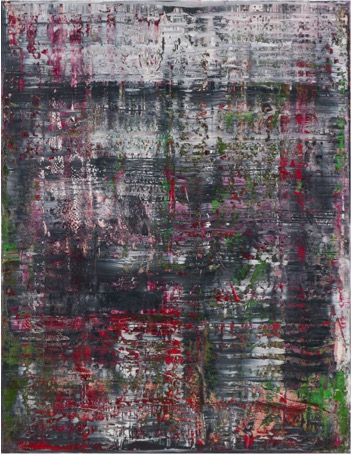MSA Annual Conference, Madrid, June 2019
Literary Dialectics: Seeking New Perspectives on Memory through Gerhard Richter’s Birkenau paintings
Thinking in terms of the politics of memory in relation to sociological approaches and cultural heritage, this paper takes Gerhard Richter’s Birkenaupaintings as the starting point. Engaging with different literary methods of reading, I will present an alternative route to the experience of art in order to re-evaluate how we negotiate universal and specific memory.
While the ancient Greeks privileged vision, lessening the significance of language in western culture,[1] in Judaism there is no passive receiving of ‘Tradition’ and reactivating the text awakens “the creative force of interpretation.”[2]This form of reading provides freedom from social language, an idea played out by Benjamin on history as subject to the structures within the present. This links to Derrida’s deconstruction of language and the idea that historicism manufactures its own unimaginable. Meanwhile, while anachronism may be a flaw in historical writing, it is a legitimate element of non-historical genres.[3]Rather, it can be an approach to narratives, to our relationship with our memory and history that offers technique for re-evaluating how we think about past and present experiences. This paper identifies the relationship between this perspective and techniques used by writers to challenge our receptive skills and reveal subjectivity, while offering new meaning and interpretation.
Considering parts of the visual that are not ‘useful’[4], rendered through painting, we can think what these elements do when attempting to engage with them. Speaking of the ‘imagination’ I refer to the experience of constructing a dialectic between what is perceived and what we know: an opportunity to identify and question assumptions of passive and active reading around the artwork. The ‘dialectical’ provides potential for the double-rhythm of collective and personal memory and thinking, and opportunity to consider the complexity of separating biography and art form. To provide a route into how the arts can embody and enact the affect of memory one might ask: can there be any part of the encounter with art that could be described as a non-discursive aspect of aesthetic experience?
Introduction to paper:
My interest is in art practice and how we might engage with art as a way to consider the activity of thinking-through-making. So while I am dealing with works that take the title from events of the Holocaust, I will approach this through a method I take throughout my research, by thinking perhaps how our thinking body engages with artworks and how this can help us to re-engage with artistic practice and the site of living and historical memory. My approach removes direct discussion on the Holocaust, perhaps because of my personal inherited memory and closeness to it, but also because my research deals with how we approach art practice through our experiences and therefore I intend to open up a space for universal memory and bringing different experiences to art. Thus, I would say that I write on process of making and thinking-through-making, and thinking how this might allow one to consider the visceral experience of making and thinking about art.
[1]Martin Jay, Downcast Eyes: The Denigration of Vision in Twentieth-Century French Thought(University of California Press, 1993). 545
[2]Marc-Alain Ouaknin, The Burnt Book: Reading the Talmud, trans. Llewellyn Brown, New Ed edition (Princeton, N.J.: Princeton University Press, 1998). 91
[3]Yosef Hayim Yerushalmi, Zakhor: Jewish History and Jewish Memory(Seattle, University of Washington Press, 1982) 18.
[4]Georges Didi-huberman, Images in Spite of All: Four Photographs from Auschwitz, Reprint edition (Chicago: University of Chicago Press, 2012).

www.gerhard-richter.com

www.gerhard-richter.com

www.gerhard-richter.com

www.gerhard-richter.com